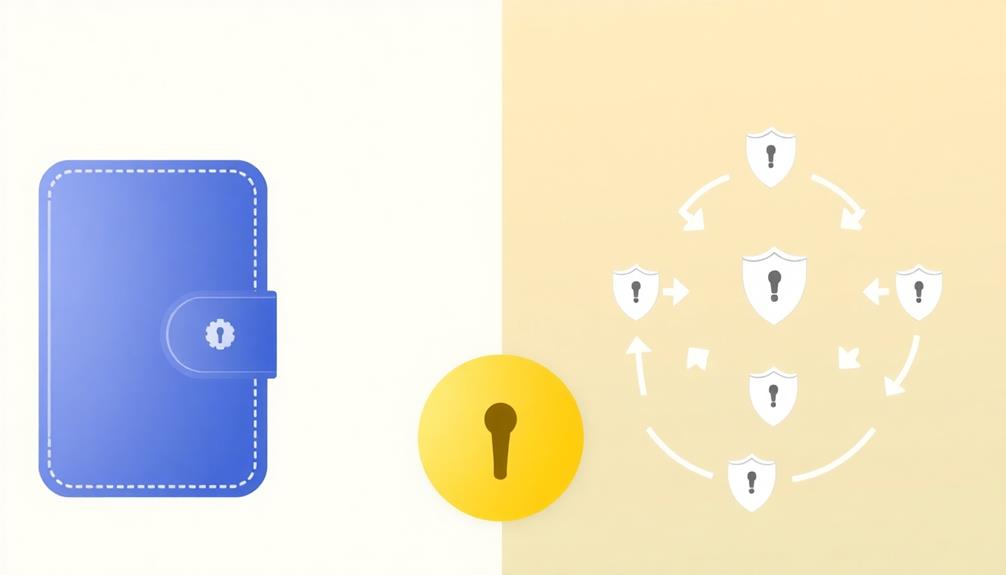The Revised Payment Services Directive (PSD2) changes how you engage with financial services in Europe. It enhances security through Strong Customer Authentication (SCA) and fosters competition among payment service providers. Now, banks must allow third-party providers access to your account data, with your consent, promoting open banking. You'll benefit from improved consumer protections, including faster refunds for unauthorized transactions. Your liability for fraudulent transactions is limited, which boosts your confidence in online payments. By understanding PSD2, you empower yourself in the financial landscape, ensuring you're ready for the evolving payment ecosystem ahead.
Key Takeaways
- PSD2, enacted in January 2018, enhances competition and innovation in the EU electronic payments market through open banking principles.
- Strong Customer Authentication (SCA) mandates two-factor authentication to improve transaction security and reduce fraud risks.
- Third-party payment providers (TPPs) require explicit consumer consent to access payment account information, promoting financial control for consumers.
- Consumers are generally not liable for unauthorized transactions, and they benefit from immediate refunds for such cases under PSD2 regulations.
- Compliance with PSD2 requires financial institutions to implement robust security measures and transparent communication regarding fees and charges.
Overview of PSD2

While it may seem complex at first, understanding PSD2 (Payment Services Directive 2) is essential for anyone involved in the financial sector. Enacted in January 2018, this European regulation aims to enhance competition, security, and innovation in the electronic payments market across the EU.
One of the key components of PSD2 is its requirement for strong customer authentication (SCA) for online transactions. This means you'll need to use at least two out of three authentication elements—knowledge, possession, and inherence—to guarantee secure payments. In a similar way, investment strategies such as those offered by a self-directed IRA allow individuals to gain greater control over their financial decisions.
PSD2 also promotes open banking by requiring banks to grant third-party payment service providers (TPPs) access to customer account information, but only with explicit consent. This approach fosters a more competitive landscape among financial service providers, ultimately benefiting you as a consumer.
Additionally, PSD2 enhances consumer protection by clarifying liability for unauthorized transactions, guaranteeing immediate refunds, and improving transparency around fees and charges.
Objectives of PSD2

The objectives of PSD2 focus on enhancing competition and innovation within the EU payments market, ultimately benefiting you as a consumer. By promoting a diverse range of payment service providers (PSPs), PSD2 encourages competition, which can lead to better services and lower costs.
This regulation opens the door for third-party access to your consumer bank account information, but only with your explicit consent. Recent cybersecurity developments, like Google Pay security measures, highlight the importance of securing transactions in this evolving landscape.
One of the critical aspects of PSD2 is its emphasis on security measures. You'll notice enhanced security protocols, including Strong Customer Authentication (SCA), which guarantees that your transactions are protected against fraud.
This not only boosts your confidence in electronic payment systems but also strengthens the protection of your financial data. Moreover, PSD2 compliance demands that both traditional banks and new entrants adopt these security measures, creating a level playing field.
This fosters an environment where innovation can thrive, leading to new payment solutions tailored to your needs. Overall, PSD2 aims to create a safer, more efficient, and competitive EU payments market, giving you the control and confidence you deserve in your financial transactions.
Third-Party Payment Providers

Three key components define Third-Party Payment Providers (TPPs) under PSD2: access, consent, and security. TPPs are authorized entities that can access your consumer payment account information, but only with your explicit consent. This access allows them to initiate payments or provide account information services, enhancing your financial experience.
By facilitating a wider array of payment options, merchant account credit processing can greatly improve customer satisfaction and drive business growth.
Under PSD2, TPPs must be registered and regulated, ensuring they meet strict security and operational requirements. This helps protect your data and enhances transaction security. The directive also mandates that Account Servicing Payment Service Providers (ASPSPs) mustn't obstruct TPPs' access to your payment accounts, fostering competition and innovation in the payments market.
The introduction of TPPs aligns with the principles of open banking, empowering you with more control over your financial data. With TPPs, you gain access to a wider range of payment services and financial products.
Importantly, TPPs are held to the same liability rules as traditional banks; they're responsible for unauthorized transactions initiated through their services and must provide you with immediate refunds. This creates a safer environment for your financial transactions while promoting a more dynamic payments landscape.
Liability Clarification

Under PSD2, liability clarification plays an essential role in defining the responsibilities of account-holding banks and payment initiation service providers. This regulation enhances transparency and accountability regarding unauthorized transactions, guaranteeing that consumers are protected.
| Aspect | Responsibility | Outcome |
|---|---|---|
| Unauthorized Transactions | Payment service providers must refund | Consumer protection is guaranteed |
| Liability for Losses | Liable provider compensates the bank | Immediate loss recovery |
| Consumer Accountability | Consumers generally aren't liable for theft | Enhanced consumer rights |
| Transparency of Rights | Clear guidelines on rights and duties | Informed consumers |
With PSD2, if you encounter unauthorized transactions, the payment service providers are mandated to refund you promptly. They'll then seek compensation from the account-holding bank for any losses incurred. Most importantly, you won't be liable for losses due to theft or misappropriation of your payment instruments, reinforcing consumer protection. This clarity in liability helps you understand your rights and responsibilities in payment transactions, making the process smoother and more secure. Understanding these aspects of liability under PSD2 can empower you as a consumer, guaranteeing a safer payment environment.
Consumer Protection Measures

Building on the clarity provided by liability measures, consumer protection under PSD2 focuses on ensuring your financial security during electronic transactions. With the rise of credit card debt in the U.S. exceeding $930 billion in 2020, it's essential to have safeguards in place.
You're entitled to immediate refunds for unauthorized transactions, which enhances your trust in these payment systems. If your payment instruments are stolen or misappropriated, you won't be liable for losses, offering you peace of mind against fraud.
If you lose your payment instrument, you'll have a maximum liability of €50, provided you report the loss promptly. This means the financial risk to you is minimized. In addition, PSD2 grants you an eight-week unconditional refund right for euro direct debits, giving you greater control over your transactions.
Additionally, awareness of credit card fraud protection can further enhance your security.
Transparency is another key aspect of consumer protection under PSD2. Payment service providers must clearly communicate all fees and charges associated with their services, so you know exactly what to expect.
This clarity reduces confusion and fosters trust in the process. Overall, PSD2 strengthens your consumer rights, making electronic transactions safer and more secure, allowing you to engage in digital commerce with confidence.
Strong Customer Authentication

Strong Customer Authentication (SCA) plays an essential role in protecting your online transactions by requiring two out of three authentication methods: something you know, something you own, and something that identifies who you are.
This approach, mandated by the PSD2 Regulation, greatly enhances the security of electronic payments and reduces security risks associated with online payments. As cyber threats evolve, implementing strategies like AI enhances threat detection can further bolster the effectiveness of SCA.
Here are some key features of SCA:
- Two-factor authentication: You'll often be prompted to provide a password along with a code sent to your mobile device.
- Biometric identification: This includes using fingerprint or facial recognition for quick and secure access.
- Exemptions for low-risk transactions: Payments under €30 or recurring payments may not need SCA, streamlining the experience for trusted users.
- Dynamic linking: Each transaction is linked to its specific amount and payee, adding an extra layer of security.
Compliance Requirements

Compliance with PSD2 is vital for financial institutions steering through the evolving landscape of electronic payments. As a financial institution, you must implement Strong Customer Authentication (SCA), requiring you to use two out of three authentication methods: knowledge, inherence, and possession. This is essential to enhance security and protect customer data.
Additionally, leveraging efficient payment solutions can streamline transaction processes, which is important for maintaining customer satisfaction in a competitive market.
Payment service providers (PSPs) like you need to guarantee that explicit consumer consent is obtained before sharing payment account data with Third Party Providers (TPPs). This involves using secure APIs to facilitate data sharing while adhering to regulatory standards for data protection and security.
Additionally, all TPPs must be registered and authorized to access payment accounts, further guaranteeing compliance.
To maintain operational integrity, you're required to conduct regular audits and compliance checks. This helps verify adherence to PSD2 regulations and identify any potential gaps.
Impact on Financial Institutions

Steering the implications of PSD2 fundamentally reshapes how financial institutions operate in today's digital economy.
You'll find that the directive introduces several significant changes, particularly regarding security and competition. Implementing Strong Customer Authentication (SCA) is now a must, requiring two-factor authentication to guarantee secure transactions. This shift not only enhances security but also builds consumer trust, much like how best beach towels of 2023 prioritize absorbency and quick drying for user satisfaction.
Additionally, financial institutions must collaborate with Third Party Providers (TPPs) through open APIs, which allows these providers to access customer data with consent. This fosters competition among payment service providers and enriches customer choice.
Key impacts include:
- Enhanced cybersecurity measures to protect against data breaches and third-party risks.
- Clear liability frameworks for unauthorized transactions, requiring immediate refunds and compensation for losses.
- Regular audits and risk assessments to guarantee compliance with PSD2.
- Transparency requirements that mandate clear communication of fees and charges associated with payment services.
As you navigate this landscape, understanding these changes is vital for adapting to new compliance mandates while improving customer satisfaction.
Future of Payment Services

As you explore the future of payment services, you'll notice how emerging technologies are reshaping the landscape.
With the rise of digital currencies and free crypto opportunities becoming more accessible, regulatory adaptations, including potential updates to PSD2, will empower consumers and enhance their payment experiences.
With these changes, expect a surge in innovative payment solutions that prioritize speed and security.
Emerging Payment Technologies
With the rapid evolution of technology, emerging payment solutions like digital wallets and contactless payments are reshaping the landscape of financial transactions.
As consumers demand convenience, payment services providers are adopting innovative payment technologies that integrate seamlessly into daily life. High-quality content on these technologies can enhance user understanding and trust, as the importance of content quality for topical authority is essential in establishing credibility.
Open banking, mandated by PSD2, allows third-party providers to create tailored financial services, enhancing user experiences and expanding options.
Key trends in emerging payment technologies include:
- Digital wallets: Simple and secure methods for storing payment information and making transactions.
- Mobile payment transactions: A projected growth to over $14 trillion globally by 2025, driven by consumer preferences.
- Strong Customer Authentication (SCA): Enhancing security through advanced verification methods that protect consumers during transactions.
- AI and machine learning: Improving fraud detection and risk management, leading to safer transaction environments.
As these technologies advance, you'll likely see a significant transformation in how you conduct transactions, making interactions faster and more secure.
The future of payments isn't just about ease; it's about creating a safe, efficient, and customer-centric ecosystem that meets your evolving needs.
Regulatory Adaptations Ahead
Amid the shifting landscape of payment services, regulatory adaptations are essential to keep pace with emerging technologies and consumer expectations. The anticipated PSD3 and the new Payment Services Regulation (PSR) aim to modernize the sector by addressing these changes and enhancing consumer protection beyond what PSD2 currently offers.
Proposed amendments from June 2023 focus on improving the regulatory landscape for payment service providers, ensuring they adapt to evolving market conditions and consumer needs. Additionally, the rise of AI in marketing is expected to influence payment services by allowing for more targeted and personalized consumer engagement.
As the UK navigates its exit from the EU, aligning UK regulations with EU standards becomes vital for seamless cross-border transactions. Future developments in open banking are expected to foster greater collaboration between banks and fintech companies, enhancing user experiences and driving innovations in digital payment methods.
These revisions will likely emphasize increased transparency and security in financial transactions, aligning with global trends towards more robust regulatory environments. By prioritizing these elements, regulatory adaptations won't only support payment service providers but also empower consumers, ensuring they can safely and efficiently engage in today's dynamic payment ecosystem.
Consumer Empowerment Trends
Consumer empowerment trends in the future of payment services are shaping a more user-centric financial landscape. With the Revised Payment Services Directive (PSD2), you gain increased control over your financial data. You can share access with Third-Party Providers (TPPs) to compare services and manage your accounts more effectively. This shift enhances transparency, as you must provide explicit consent before any data sharing occurs.
Key trends driving consumer empowerment include:
- Strong Customer Authentication (SCA): New security measures reduce fraud risks, boosting your confidence in electronic payments.
- Open banking: You can access a wider range of payment services and innovative financial products.
- Greater competition: More TPPs enter the market, offering you better choices and potentially lower costs.
- Personalized services: Future developments may lead to tailored financial solutions that meet your unique needs.
As these trends unfold, you'll find yourself at the center of a financial ecosystem that prioritizes your preferences and security, ultimately enhancing your overall payment experience.
Embrace the changes, and take advantage of the empowered role you now play in your financial journey.
Frequently Asked Questions
What Is the Basic Explanation of PSD2?
You're looking for a basic explanation of PSD2. It's a regulation that boosts competition in payment services by enforcing strong customer authentication and allowing third-party access to bank data, enhancing security and consumer protection.
What Are the Key Requirements for PSD2?
You need to guarantee strong customer authentication, implement open APIs for secure access, register payment service providers, communicate fees transparently, and conduct regular audits to maintain compliance and protect consumer data effectively.
What Is the PSD2 Payment Method?
When you think of payments, imagine swiping a magic card. The PSD2 payment method lets you authorize transactions securely through third-party apps, enhancing your experience while keeping your financial details safe and sound.
What Are the Principles of PSD2?
You'll find that PSD2 focuses on enhancing competition, ensuring consumer protection, and mandating strong security measures. It emphasizes your rights, like limited liability for unauthorized transactions and guarantees swift refunds for any issues that arise.
Conclusion
In a world that's rapidly changing, PSD2 acts as a guiding star, illuminating the path to safer and more innovative payment solutions. As you navigate this new landscape, you'll find yourself empowered by stronger protections and the freedom to choose how you manage your money. Embrace these changes, for they're not just regulations—they're stepping stones toward a brighter financial future. Together, we're shaping a new era of trust and transparency in every transaction.










